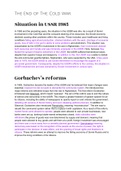The End of The Cold War
Situation in USSR 1985
In 1985 and the preceding years, the situation in the USSR was dire. As a result of Soviet
involvement in the Cold War and the conquent draining of its resources, the Soviet economy
declined causing other problems within the country. These included, poor healthcare and living
conditions failing agricultural production, strained relations with the west, shortage of consumer
goods, loss of faith in the govt’s ability to solve problems and alcoholism. This situation was
exacerbated by the USSR’s involvement in the war in Afghanistan: their involvement drained
both resources and morale and was immensly unpopular in the USSR. Here, because they
feared the spread of Islamic extremism in the USSR, the USSR suffered tremendous losses
despite their superior troops and weaponry. In addition to this, the USSR was unable to defeat
the anti-communist guerilla fighters, Mujhandain, who were supported by the USA. A few years
later in 1979, the USSR aimed to use Soviet intervention to encourage the support of a
pro-soviet government. Consequently, despite the USSR’s efforts to the contrary, the situation in
USSR remained dire and was worsened by Soviet involvement in various wars.
Gorbachev’s reforms
In 1985, Gorbechev became the leader of the USSR and he believed that major changes were
essential, however he did not want to dismantle the communist system. He introduced two
major reforms and withdrew troops from the war in Afghanistan. The first reform Gorbechev
introduced was Glasnost, which meant “openess”. The aim of this reform was to end the culture
of silence and censorship in the USSR. This meant a greater freedom of speech speech for all
its citizens, including the ability of newspapers to openly report on and criticise the government,
debating old versions of Soviet history and even releasing politcal prisoners. In addition to
Glasnost, Gorbachev also introduced Perestroika, meaning “reconstruction”. The aim was to
rebuild the communist system rather that to replace it with capitalism. As a result of this reform,
market forces were allowed to operate, people were allowed to own private businesses, new
banks were set up, bankrupt state-owned enterprises closed, state subsidies were
withdrawn,the prices of goods was now determined by supply and demand, meaning that
people were allowed to buy goods and sell them at a profit, foreign investment was encouraged
and there was a move away from a centrally planned government. Demokratiya meaning
democracy,was based on the recognition of the people as the source of power, the right to
participate in the decision of state affairs, and the granting of broad rights and freedoms to
citizens. These reforms were an attempt to improve the failing economy of Soviet Russia and to
improve the living conditions of its citizens.
, Impact of Gorbachev’s reforms
Despite the well-meaning intentions behind Gorbachev’s reforms, they negatively impacted
Soviet Russia and contributed to an economic recline. With the introduction of Glasnost, the
communist party began to lose control over the USSR and the soviet citizens became more
willing to openly express their criticism of the government. The introduction of Perestroika saw
Gorbachev losing support and the shortages occurring in Soviet Russia tremendously
worsened, making the living conditions of the soviet people more difficult; the prices of goods
and the cost of living increased by 140%, the people became increasingly unhappy and the
economy declined. Whilst the reforms had a negative impact on Soviet russia, the reforms were
welcomed by the West, thus improving the strained relations Russia had with them. Gorbachev
held numerous meetings with Ronald Reagan, the US President and both East and the West
agreed to reduce nuclear weaponry, greatly reducing military spending. Hence, whilst
Gorbachev’s reforms did not improve the dire situation of Soviet Russia, it improved the USSR’s
relations with the West which was an important step after the cold war.
Eastern Europe
Context
The USSR used the Warsaw Pact (1955) to enforce control and crush resistance in Eastern
Europe. Most of the countries in Eastern Europe were under Soviet control after WW2 and
became known as satellite states. By the 1980s, the people living in these country wanted
change and they were significantly inspired by the events in Poland.
Events in Poland
The events which occurred in Poland including the creation of Solidarity and the action taken by
its members inspired many other eastern european countries to do the same. In 1979, the visit
of Pope John Paul ii, a significant religious leader in Poland and a critic of communism, inspired
demands for greater freedom. At the same time, Poland was suffering with major economic
problems, including a drastic increase in prices and a decrease in standard of living. In 1980, a
group of Workers in Gdansk formed a Trade Union, Solidarity. Solidarity made 21 demands to
its government, which included the right to form free trade unions, the right to broadcast roman
catholic church services and also to put an end to censorship among others. When the
government agreed to these demands, Solidarity’s membership drastically increased from 3 to 9
million members; the government did not take any action based on these demands. As a result
of its anti-communist policies, Solidarity was seen as an enormous threat to communist
domination in Eastern Europe. Thus, in December 1981, approximately 10 000 leaders of




